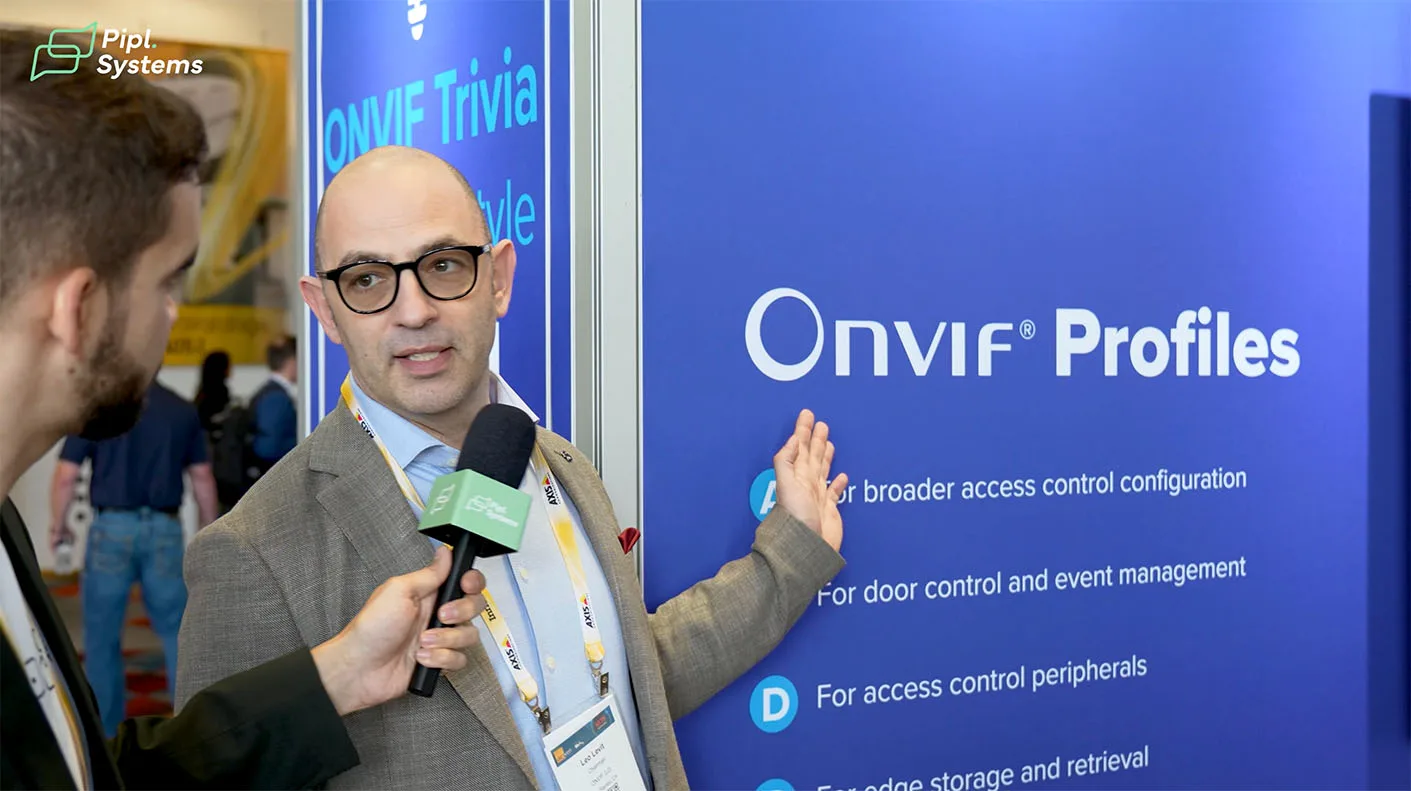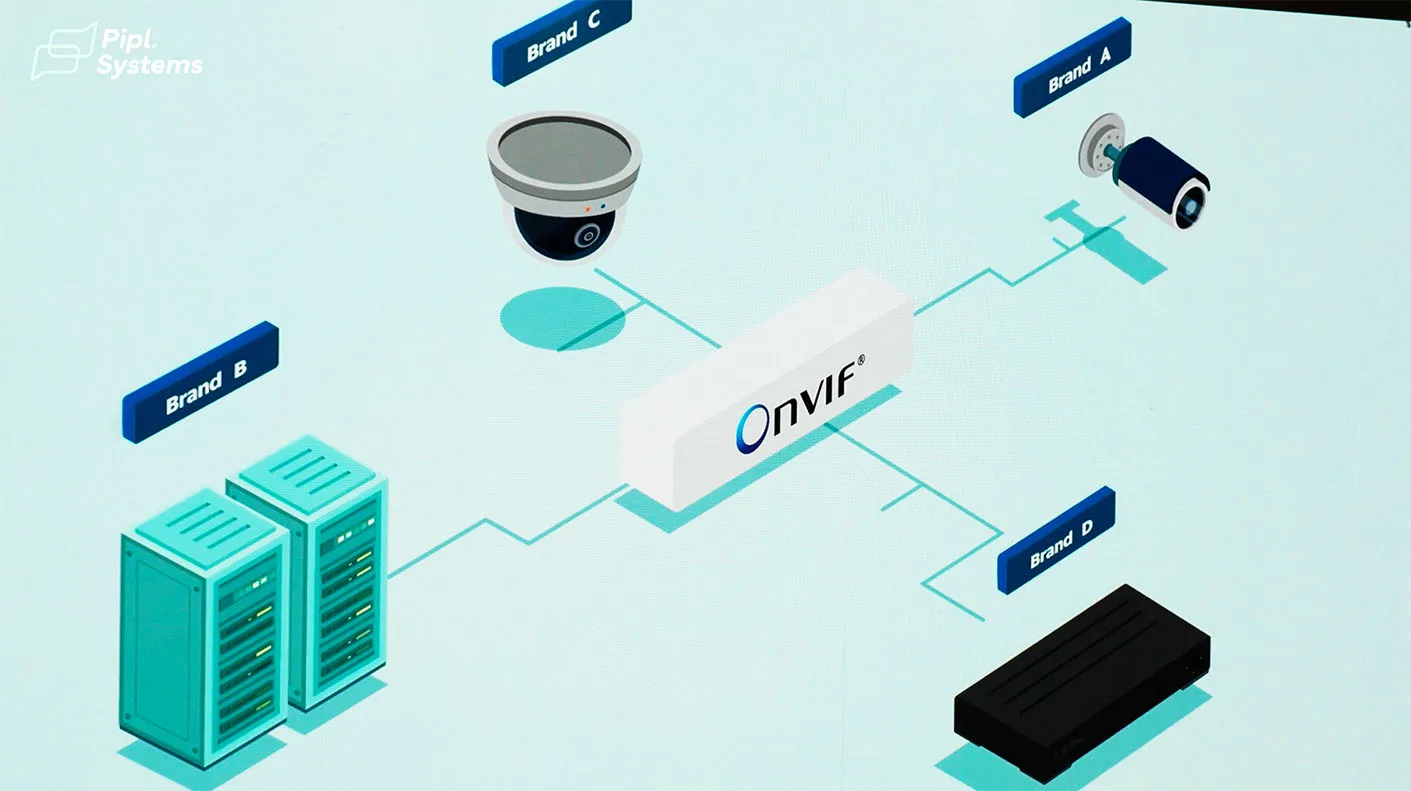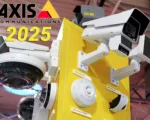Interview Kickoff: Live from the ONVIF Booth
During ISC West 2025, I had the opportunity to sit down with Leo Levit, Chairman of the ONVIF Steering Committee, to unpack one of the most common phrases I heard from manufacturers at the show:
“We integrate with ONVIF.”
But what is ONVIF, really? Why is it so critical in today’s IP-based security infrastructure?
According to Leo:
“ONVIF is a standardization organization that works toward interoperability and standardized communication between products in the security industry.”
In simple terms, ONVIF defines a universal language that lets security devices — like ONVIF cameras, NVRs, access systems, and software platforms — work together, even when built by different brands. This is made possible by the ONVIF protocol, which streamlines everything from video streaming to alarm events and analytics.

Founded in 2008 by Axis, Sony, and Bosch, ONVIF now unites nearly 470 member companies. Together, they’ve shaped a common framework that continues to evolve — ensuring IP-based surveillance stays both open and forward-compatible.
At the ONVIF booth, this message was crystal clear. A large interactive display invited attendees to test their knowledge through an ONVIF Trivia game, while a dedicated wall explained the purpose of ONVIF profiles in bold, simple terms. It wasn’t just marketing — it was a live demonstration of how standardization empowers integration.
Understanding ONVIF’s Role in Standardization
What truly sets ONVIF apart is its profile-based structure, which simplifies adoption and ensures compatibility. As Leo explained:
“Each profile includes a set of required functions that manufacturers must implement. Once a product passes testing, the manufacturer uploads a declaration of conformance to our open database.”
These ONVIF profiles act like modular building blocks. Each one defines specific capabilities that a product must support to ensure seamless integration. That’s why ONVIF isn’t just a guideline — it’s an enforceable standard, backed by certification and public accountability.

Here’s a quick breakdown of the ONVIF profiles prominently featured at the booth:
- Profile A – For broader access control configuration
- Profile C – For door control and event management
- Profile D – For access control peripherals
- Profile G – For edge storage and video retrieval
- Profile M – For metadata and event tagging used in analytics
- Profile S – For basic video streaming (common in legacy ONVIF cameras)
- Profile T – For advanced video streaming, including H.265 and analytics
Each ONVIF profile is purpose-built. For example, Profile T supports modern ONVIF IP camera features like HDR video and motion detection, while Profile A enables full control over complex access systems — doors, credentials, zones, and more.
The History of ONVIF and Its Founders
To understand where ONVIF is going, it helps to know where it started.
“It was founded in 2008 by Axis, Bosch, and Sony,” said Leo, referring to three of the most influential names in the IP surveillance world.
Their vision? To solve the growing problem of incompatible devices in an industry rapidly shifting toward IP-based systems.
By establishing a unified framework for communication — the ONVIF protocol — these founding companies helped create the first meaningful standard for interoperability between video surveillance and security products.

Fast forward to today, and ONVIF has expanded far beyond its original trio of founders:
“Today, we have around 470 members globally,” Leo shared proudly.
This includes major manufacturers, software vendors, and security solution providers from every region of the world. Together, they’ve contributed to a public catalog of over 32,000 ONVIF-conformant products — ranging from basic ONVIF cameras to NVRs, access control hardware, and cloud-based analytics platforms.
It’s not just about quantity. The steady growth of ONVIF membership reflects industry-wide recognition of how vital cross-compatibility and openness have become.
ONVIF’s Mission: Promoting Interoperability and Open Standards
As Leo put it simply:
“Our mission is to help end users avoid vendor lock-in.”
In a field where long-term investments in ONVIF IP camera infrastructure can run into the tens or hundreds of thousands of dollars, flexibility isn’t just a nice-to-have — it’s critical. ONVIF exists to guarantee that flexibility, ensuring you’re not stuck with one vendor’s ecosystem.

By using open standards and the modular ONVIF profiles model, integrators and end users can build systems that evolve with time and technology. That means fewer bottlenecks, lower costs for upgrades, and more choices when expanding.
Whether you’re deploying ONVIF security cameras for a retail business or designing a multi-site government installation, interoperability allows each component to do its job, regardless of who made it.
This mission is backed by a concrete certification process and a constantly updated ONVIF camera list, which helps integrators select compatible gear confidently.
If you’re curious about what ONVIF is used for or how it compares to proprietary protocols, check out our full breakdown:
👉 Don’t Buy a Video Surveillance System Without ONVIF Support: Here’s Why and What is ONVIF?
Why ONVIF Matters to Manufacturers, Integrators, and End Users
When we talk about ONVIF-conformant products, we’re talking about more than just a checklist — we’re talking about trust.
For manufacturers, building ONVIF compatibility into their devices means gaining access to a massive market of ONVIF software platforms and devices that expect seamless communication. For system integrators, it means easier deployments, faster troubleshooting, and broader product catalogs to work from.

Leo explains it best:
“This gives flexibility and peace of mind, especially for big investments in security infrastructure. For integrators, it’s also great — it expands the catalog of compatible products to over 32,000 devices.”
And for end users? It means knowing that your security investment won’t become obsolete when your needs evolve.
Whether you’re installing an ONVIF IP camera in a residential building or designing a multi-layered enterprise solution, compatibility is everything. You’re no longer locked into a single ecosystem. You can scale and swap without sacrificing stability.
If you’re currently evaluating your options, we recommend reading our expert round-up of the Best AI Security Cameras for 2025 — most of which now come ONVIF-ready by default.
How New Manufacturers Join and Get Certified
ONVIF isn’t a closed club. In fact, as Leo emphasized, it’s open to any company willing to adopt and implement the standards.
“First, they join ONVIF as a member. We have different membership levels. Even the most basic level gives access to our specifications, testing tools, and the member community.”
The process looks like this:
- Join as a member – companies choose a tier based on their needs.
- Access ONVIF specifications and tools – even entry-level members can start implementing immediately.
- Perform self-testing – using provided tools to ensure conformance.
- Declare compliance – passing products get added to the public ONVIF database.

More engaged members can go beyond technical conformance and help shape future ONVIF profiles by participating in working groups, roundtables, and development sessions.
“That includes face-to-face meetings, collaboration with peers, and direct involvement in developing new standards.”
For startups and established OEMs alike, ONVIF offers a powerful route to industry relevance — backed by a trusted certification model.
Need the right tools to start testing your own ONVIF-compatible gear? Check out our updated guide:
👉 6 Best IP Camera Monitoring Software 2025: Which Is the Best Choice?
Getting Involved: Membership Tiers and Influence
Joining ONVIF isn’t just about compliance — it’s about contributing to the future of the security industry.
“If they want to go further — influence standards, join working groups, and help shape future specifications — they can upgrade to a higher membership level.”
ONVIF offers multiple membership tiers, each with increasing access and influence:
- User-level members get access to the technical specs and conformance tools.
- Full members can participate in working groups, vote on updates, and propose new ONVIF IP camera standards.

Collaboration plays a critical role. Members meet regularly — both virtually and in person — to review proposals, test implementations, and ensure that new ONVIF profiles meet the needs of real-world deployments.
To explore how your company can get involved, visit the official membership portal:
👉 onvif.org/members
What ONVIF Is Showcasing in 2025
Unlike other booths packed with shiny new hardware, ONVIF’s presence at ISC West this year was more educational in nature.
“For us, this show is about educating the market — integrators, end users, and manufacturers alike — about the importance of open standards and interoperability.”
The ONVIF team didn’t introduce any new profiles in 2025. Instead, they doubled down on strengthening existing integrations and gathering feedback from their vast ecosystem of device makers and system builders.

Their booth was designed to start conversations — with a prominent ONVIF profiles overview, real-time trivia challenges, and even interactive demos showing how ONVIF cameras and access control systems work in tandem across vendors.
In short, the message was clear: ONVIF is not standing still — it’s listening.
Final Thoughts from ONVIF
Leo Levit ended our conversation by highlighting ONVIF’s collaborative nature and future-looking goals:
“We’re also here to connect with our members and understand what they need next from ONVIF in terms of standardization.”
That mission — listening, evolving, and building around the needs of integrators and manufacturers — is what keeps ONVIF relevant in a changing security landscape.

If you’re planning your next project or evaluating vendors, don’t overlook the importance of open standards and certified compatibility.
For those looking to stay ahead of emerging technologies and new market entrants, we invite you to follow the Pipl Systems YouTube channel — your front-row seat to in-depth walkthroughs, field tests, and expert breakdowns.
You’ll also find technical articles, comparative reviews, and implementation guides on our website, pipl.systems — crafted for professionals who value substance over sales talk.
This is where innovation meets real-world application.
FAQ – Everything About ONVIF and IP Security Standards
What is ONVIF and why is it important in security systems?
ONVIF is a global standard that ensures interoperability between IP-based security products, including video cameras, recorders, and software platforms. It helps users mix and match products from different brands without compatibility issues.
What is an ONVIF profile?
An ONVIF profile is a set of standardized functions — such as streaming, PTZ control, audio, or analytics — that products must support to be certified. Popular profiles include Profile S (streaming), Profile G (recording), and Profile T (advanced video).
How do I know if my camera supports ONVIF?
You can search the official ONVIF camera list on their website. Over 32,000 ONVIF-conformant products are listed, including ONVIF IP cameras, NVRs, and software tools.
What is ONVIF Device Manager used for?
ONVIF Device Manager is a free utility that helps you discover, configure, and test ONVIF-compatible devices on your local network. It’s widely used by installers and system integrators.
Can I use ONVIF cameras with any NVR?
Most modern ONVIF NVRs support Profile S and are compatible with a wide range of ONVIF cameras. However, advanced features like motion detection or audio may require matching ONVIF profiles.
Is ONVIF secure?
ONVIF itself focuses on interoperability, but security depends on how each manufacturer implements features like encryption, user access, and firmware updates. Always choose certified ONVIF security cameras from reputable vendors.
















